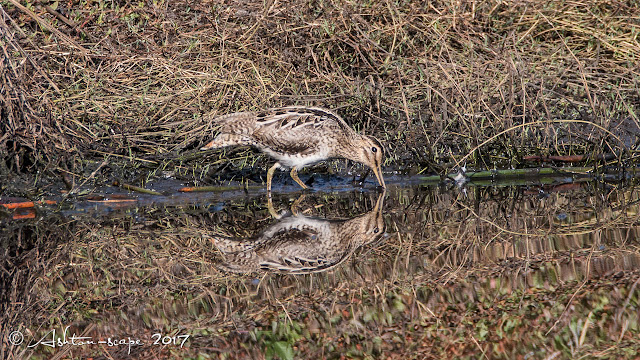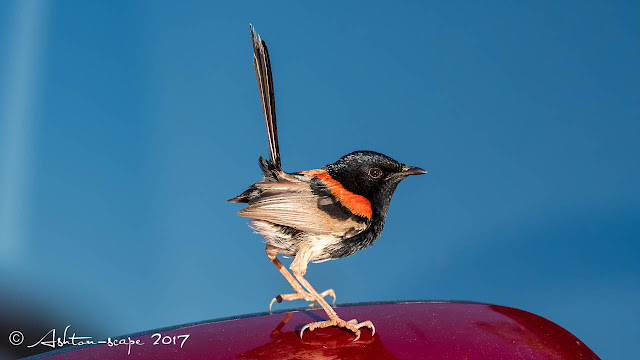Cooranbong Summary
The last couple of weeks have been so busy that I have neglected the blog. The big news is that a Latham's Snipe is feeding on the pond on Deaves Rd. I have seen them there before about 3 years ago. They come to this pond when the water level is low enough to leave an exposed bank to feed on. Latham's Snipe are migratory birds that spend our winter in Japan. They return here is October usually. They are usually hard to find, being much the same colour and the weeds and grass where they are found. Further they are a skittish bird and fly off very quickly if disturbed.
Last week I found a Swamp Harrier hunting over the paddock at the north-east part of Sandy Creek Walk. It was flying low over the paddock, obviously in hunting mode. It often flew with its legs down.
I learned that the white spot on the rump was diagnostic. This helps distinguish it from the Spotted Harrier. The Swamp Harrier is the same as the Harrier Hawk of New Zealand.
There are a few White-necked Herons around at the moment. This one is staring to show the spots on its neck that indicate it is developing preeding plumage.
When I went on the U3A walk last week we found a Ring-tailed Possum with its young one riding on its back. I am not sure what they were doing out during daylight hours. The baby one was difficult to see most of the time as it tended to ride on the side of the parent that I could not see.
The other non-avian observation was a very young white rabbit. The rabbit population was decimated earlier this year and I thought that we had seen the last of the white rabbits. I only see half a dozen rabbits on my walks currently, compared to the hundreds I would see in the same area earlier this year.
The White-cheeked Honeyeaters have been very cooperative lately. We have always had them here but they have typically been too far away to photograph well. My best pictures to date have been from Sawtell. This week though, I have had several encounters with them at eye-level on my patch in Cooranbong.
This one appears to have caught several insects in its bill at the same time. I am guessing that there is a nest nearby as it appears to be making no effort to eat the insects; it just carried them around.
This male Satin Bowerbird was gathering leaves to line its dancing platform outside its bower. This is the one near the Swing
bridge. The bower is well looked after and has a large collection of blue objects.
The Superb Fairy-wrens are busy in their territories. The males are coloured up and looking after their female companions.
There is a Fan-tailed Cuckoo calling high up in the trees in the area. I will need to keep my eyes open to see if there is a young one being attended to by the Fairy-wrens.
Not to be forgotten, the Variegated Fairy-wrens are living in the same area. The males are fully coloured now. I get the impression that they have a larger territory that the Superb Fairy-wrens but I am not 100% sure. I will need to do a lot more observation.
Another surprise this week was the discovery of a Yellow Robin nest. It was quite by accident and I had actually taken the photograph before I realised that I had photographed a nest with chicks in it. The chicks are partially fledged so it will be interesting to see how long it is before they leave the nest.
I found the Yellow Thornbills this week, pretty much in the same place where I have previously found the Striated and Brown Thornbills. Like all the thornbills they are forever on the move and consequently difficult to photograph.
The Dollarbirds have started to appear around the place. They are sitting on the dead branches of the highest trees around. I wish they would sit a bit lower down sometimes so that I can get good photographs of them.
Finally, while I was photographing the Latham's Snnipe this morning a Royal Spoonbill flew in. It had some fairly well developed plumes indicating it was in breeding plumage.
It did not stay very long and flew off over the trees and out of sight.
Last week I found a Swamp Harrier hunting over the paddock at the north-east part of Sandy Creek Walk. It was flying low over the paddock, obviously in hunting mode. It often flew with its legs down.
I learned that the white spot on the rump was diagnostic. This helps distinguish it from the Spotted Harrier. The Swamp Harrier is the same as the Harrier Hawk of New Zealand.
There are a few White-necked Herons around at the moment. This one is staring to show the spots on its neck that indicate it is developing preeding plumage.
When I went on the U3A walk last week we found a Ring-tailed Possum with its young one riding on its back. I am not sure what they were doing out during daylight hours. The baby one was difficult to see most of the time as it tended to ride on the side of the parent that I could not see.
The other non-avian observation was a very young white rabbit. The rabbit population was decimated earlier this year and I thought that we had seen the last of the white rabbits. I only see half a dozen rabbits on my walks currently, compared to the hundreds I would see in the same area earlier this year.
The White-cheeked Honeyeaters have been very cooperative lately. We have always had them here but they have typically been too far away to photograph well. My best pictures to date have been from Sawtell. This week though, I have had several encounters with them at eye-level on my patch in Cooranbong.
This one appears to have caught several insects in its bill at the same time. I am guessing that there is a nest nearby as it appears to be making no effort to eat the insects; it just carried them around.
This male Satin Bowerbird was gathering leaves to line its dancing platform outside its bower. This is the one near the Swing
bridge. The bower is well looked after and has a large collection of blue objects.
The Superb Fairy-wrens are busy in their territories. The males are coloured up and looking after their female companions.
There is a Fan-tailed Cuckoo calling high up in the trees in the area. I will need to keep my eyes open to see if there is a young one being attended to by the Fairy-wrens.
Not to be forgotten, the Variegated Fairy-wrens are living in the same area. The males are fully coloured now. I get the impression that they have a larger territory that the Superb Fairy-wrens but I am not 100% sure. I will need to do a lot more observation.
Another surprise this week was the discovery of a Yellow Robin nest. It was quite by accident and I had actually taken the photograph before I realised that I had photographed a nest with chicks in it. The chicks are partially fledged so it will be interesting to see how long it is before they leave the nest.
I found the Yellow Thornbills this week, pretty much in the same place where I have previously found the Striated and Brown Thornbills. Like all the thornbills they are forever on the move and consequently difficult to photograph.
The Dollarbirds have started to appear around the place. They are sitting on the dead branches of the highest trees around. I wish they would sit a bit lower down sometimes so that I can get good photographs of them.
Finally, while I was photographing the Latham's Snnipe this morning a Royal Spoonbill flew in. It had some fairly well developed plumes indicating it was in breeding plumage.
It did not stay very long and flew off over the trees and out of sight.




















Comments
Post a Comment